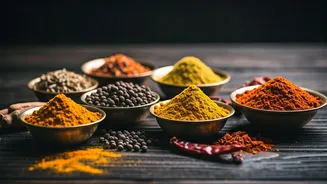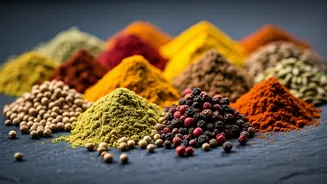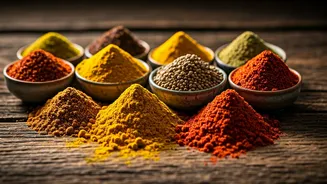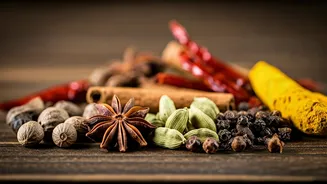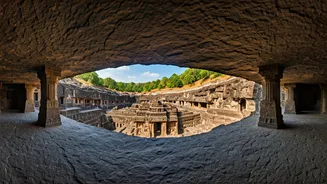A Land of Flavors
India's cuisine is as diverse as its geography and culture. Influenced by centuries of history, trade, and regional variations, Indian food is a tapestry
woven from a multitude of flavors, textures, and aromas. Northern India, with its Mughal influence, boasts rich, creamy curries and tandoor-cooked meats, while the South is known for its spicy stews, rice dishes, and use of coconut. East India presents a lighter, seafood-centric cuisine, and the West offers a blend of coastal and inland flavors. Spices play a crucial role, with each region using a unique blend to create its signature dishes. The use of fresh, seasonal ingredients adds another layer of complexity to Indian cooking, making each meal a unique experience. This diversity is what sets Indian cuisine apart and makes it so appealing to palates around the world.
North Indian Delights
Northern Indian cuisine is largely influenced by the Mughal era, reflecting rich flavors and complex cooking techniques. Staples include creamy curries, often with a tomato or cashew-based gravy, and tandoori dishes, where meat and vegetables are marinated in yogurt and spices before being cooked in a clay oven. Popular dishes include butter chicken, a mildly spiced chicken in a creamy tomato sauce; various types of kebabs, which are grilled or roasted meat skewers; and palak paneer, a spinach and cheese dish. The use of dairy products like ghee (clarified butter), cream, and yogurt is prominent, adding richness and depth to the dishes. Flatbreads like naan and roti, baked in the tandoor or on a griddle, are essential accompaniments. The region's cuisine is known for its generosity in using spices, creating dishes with bold, comforting flavors that are perfect for a satisfying meal. The aroma of cardamom, cloves, and cinnamon often permeates the air, promising a culinary experience that excites the senses.
Southern Spice Route
South Indian cuisine is characterized by its use of rice, lentils, and a wide array of spices, especially chilies, tamarind, and curry leaves. The food is typically lighter and spicier than its northern counterpart. Dishes often feature coconut milk and tamarind, adding a unique tang and richness. Idli and dosa, fermented rice and lentil pancakes, are popular breakfast items served with sambar (a lentil-based vegetable stew) and chutney. Seafood is common in coastal regions, with dishes like fish curry and prawn fry. Each state in South India has its own culinary specialties, with Andhra Pradesh known for its fiery curries and Chettinad cuisine from Tamil Nadu famed for its use of black pepper and other spices. The emphasis is on fresh ingredients, allowing the natural flavors of the produce to shine through. The use of regional spices, herbs, and cooking techniques showcases the distinct character of each dish, offering a diverse array of tastes for the adventurous palate.
Eastern Culinary Gems
The East Indian culinary scene presents a unique blend of flavors, often influenced by its proximity to the coast and neighboring countries. The cuisine of West Bengal features rice and fish as staples, with dishes like fish curry being a daily staple. Mustard oil is frequently used as a cooking medium, adding a distinctive flavor profile. The region is known for its sweets, especially those made with milk and sugar, such as rasgulla and sandesh. Dishes are generally prepared with a balance of sweet, sour, and spicy elements. Moving eastward, the states like Assam and Manipur boast a cuisine that incorporates a variety of fresh herbs and local produce, reflecting a deeper connection to nature. Dishes often focus on seasonal vegetables and meats, cooked with a light hand to preserve the natural flavors. Fermented foods and local fruits are often components of the dishes, showcasing the land's bounty. This region's food offers a light, fresh, and often aromatic culinary experience.
Western Culinary Wonders
West Indian cuisine is a delightful mix of coastal and inland flavors, with significant influences from Portuguese and Gujarati cultures. Goa, with its coastal heritage, offers a wide selection of seafood, often prepared with tangy vinegar and chili-based sauces. Vindaloo, a spicy pork dish, is one of the most famous Goan specialties. Gujarat is renowned for its vegetarian cuisine, characterized by a sweet and savory taste profile. Dishes often include a combination of lentils, vegetables, and sweets, emphasizing a balance of flavors. Maharashtra, another state in the west, showcases a wide range of dishes, from the street food favorite vada pav to the spicy curries. The use of peanuts, sesame seeds, and jaggery is common, providing unique textures and flavors. Coastal dishes often include coconut and various spices, reflecting the region's diverse culinary influences. This cuisine emphasizes the use of fresh, locally sourced ingredients and a balanced approach to spices, offering a wide array of flavors for the adventurous eater.
Spices: The Heartbeat
Indian cuisine would not be what it is without its exquisite spice blends. Spices are at the heart of the cooking, used not only for flavoring but also for their health benefits. Turmeric, with its vibrant color and anti-inflammatory properties, is a staple. Cumin, coriander, and cardamom are frequently incorporated, each adding a unique layer of aroma and taste. Chili peppers contribute the heat, varying from mild to fiery depending on the region and dish. The careful blending of spices, often roasted and ground fresh, is crucial. Each family and region have their own secret blends that are carefully passed down through generations. These spice combinations enhance not only the flavor but also the visual appeal of dishes, transforming simple ingredients into complex and flavorful creations. Spices are also used in various remedies, highlighting the connection between food and wellbeing, a core value in Indian culinary tradition.
Regional Specialties
Each region of India boasts its own unique specialty dishes. Rajasthan is famous for its fiery curries, rich in spices and often served with flatbreads. Punjab is known for its creamy curries like butter chicken and dal makhani, made with black lentils and cream. The coastal states offer a variety of seafood dishes, from fish curries to grilled prawns, all enhanced by fresh herbs and local spices. Every region, from the Himalayas to the southernmost point, has its own unique culinary secrets. Biryani, a rice dish cooked with meat and spices, has many versions throughout the country, each reflective of a distinct culture. Street food such as chaat, momos, and various types of dosas is incredibly popular across the nation. This wide variety of regional specialties shows the country’s diverse landscape and culinary heritage, providing a rich, endless variety of flavors to sample and enjoy. The variations reflect each state's culture and history, adding a personal touch to every meal.
Culinary Culture
Beyond the food itself, Indian cuisine reflects a deep cultural significance. Eating is a social event, often a communal gathering that brings families and communities together. Meals are enjoyed at all times of the day, from quick street food snacks to elaborate dinner feasts. The focus on fresh ingredients and seasonal produce demonstrates a deep appreciation for the land and its bounty. Traditional practices, such as eating with hands, are common, adding a tactile element to the experience. Festivals and celebrations are often marked with special dishes and sweets, making food an integral part of religious and cultural events. Vegetarianism is widely practiced in India, offering a wide array of vegetable and legume-based dishes that are both nutritious and flavorful. The emphasis on hospitality and sharing food reflects values of generosity and community that are core to the culture, making Indian cuisine a uniquely social and enjoyable experience.
